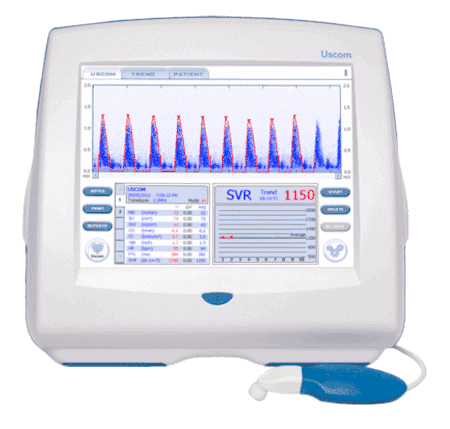USCOM 1A
Non-invasive Doppler monitoring with advanced hemodynamics
USCOM 1A uses advanced Doppler hemodynamics to monitor cardiac blood flow. Stroke Volume (SV) monitoring changes the way we manage fluid, inotropes, and vaso-actives, and how we diagnose and manage sepsis, heart failure and hypertension.
USCOM 1A accurately measures blood flow, Stroke Volume and Cardiac Output, across the aortic or pulmonary valve. Regardless of whether the patient is in sinus rhythm, atrial fibrillation, on vasopressors, on and off ventilation or experiencing active autonomic regulatory changes such as in sepsis, USCOM 1A is reliable. This distinguishes USCOM 1A from blood pressure devices which display surrogates of flow derived from blood pressure measures.
USCOM 1A is improving management and saving lives in the neonatal, pediatric, critical care, emergency, perioperative, oncological, maternal and perinatal populations. Appropriate use of the USCOM 1A reduces mortality in septic shock patients.
Over 500 publications confirm the clinical utility of the USCOM 1A and demonstrate its outstanding reliability and reproducibility and role in clinical medicine – and it’s non-invasive.

USCOM 1A – Primary Applications
Preload – Fluid management, fluid responsiveness and fluid optimization; when to start and when to stop fluid.
Sepsis – Hemodynamic status, including DO2, Stroke Volume (SV) and Cardiac Output (CO) optimization.
Shock – Shock differentiation with identification of underlying hemodynamic derangements.
Cardiac Function – Assessment of systolic function, heart failure and cardiopulmonary exercise testing.
Hypertension – Differentiate and identify SVR and CO/SV derangement.
Hypotension – Differentiate and identify SVR and CO/SV derangement.
USCOM 1A – How It Works – Clinical Benefits
Primary Clinical Areas
Pediatrics – Identifies distinct patterns of shock and monitors therapy. USCOM 1A is applicable for fluid, sepsis and shock management and systolic function assessment of cardio toxic oncology patients. (More info)
Critical Care Medicine – Less than 50% of ICU patients given fluid boluses are volume responsive. USCOM 1A provides non-invasive Stroke Volume monitoring to increase sensitivity and specificity in excess of 90%. USCOM 1A is applicable for hemodynamic and ventilation management in the Medical and Surgical ICU, the stepdown unit and outreach. (More info)
Emergency Medicine – USCOM 1A provides front line hemodynamic assessment and detection of hypotension, shock differentiation, early sepsis management, triage and retrieval. (More info)
Perioperative Medicine – Normal Cardiac Output pre-anesthesia improves anesthetic outcome. Perioperative fluid and hemodynamic optimization improves recovery time and patient outcomes and reduces cost. USCOM 1A is used for pre-operative assessment, perioperative management and post-surgical monitoring. (More info)
Maternal Medicine – Pre-eclampsia occurs in 3-5% of all pregnancies which results in poor maternal and fetal outcomes and is responsible for 15-20% of all maternal deaths. USCOM 1A detects early pre-eclampsia and is used in Maternal-Fetal and IVF clinics and the Maternal ICU for gestational hypertension, intrauterine growth retardation. (More info)
Neonatology – Neonatal sepsis is a leading cause of infant death. The quicker an infant receives treatment, the better the outcome. Serial measurement of SVI, CI and SVRI monitors hemodynamic changes and identifies optimal therapeutic response.(More info)
